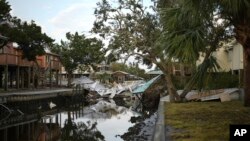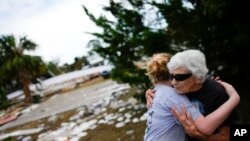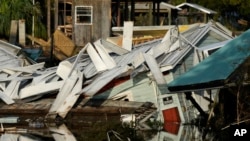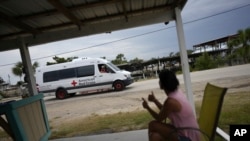Anabel Bodine’s internet service had been down for days. By the time she knew Hurricane Idalia was heading straight for her hometown of Perry, Florida, it was too late to evacuate.
“I was so scared. At one point my mobile home was just rocking back and forth with me in it. I thought it was going to tip over,” she told VOA. “But I’m only 130 pounds [59 kilograms] so I was afraid to go outside because I was worried I’d just blow away.
“Dark skies, wild wind and rising water. And when it finally ended and I opened the door, you saw all the damage it did. Trees slammed into homes. Power lines down everywhere. And it’s so hot here, but the electricity’s pretty much out in the whole town, so we’re just roasting.”
Idalia hit the Big Bend region of Florida as a Category 3 hurricane. Winds of more than 200 kph were the strongest recorded in that part of the state in more than a century, tearing storefronts from foundations, peeling roofs from homes and leaving hundreds of thousands of residents from Florida to North Carolina without power.
But as people survey the damage, it’s clear the hurricane created nightmares for those far outside the storm’s path as well.
“Honestly, the hurricane wasn’t anywhere near us,” said Pete Genova, a resident of the coastal town of Port Richey, Florida, nearly 260 kilometers south of Perry.
“But it didn’t matter - the storm surge got us,” he said.
That storm surge, which rose as high as 2.75 meters above sea level in some places, was the result of a catastrophic combination of a powerful hurricane and a full “supermoon” that — because of the moon’s gravitational pull on the Earth — would have caused higher tides even without the accompanying storm.
“My house flooded with water from the Gulf, same with my neighbors,” Genova said. “Who knows how long this is going to take to clean up? The streets are lined with destroyed personal stuff and waterlogged furniture, and we’re all going to have to replace our floors."
'Worst storm I’ve experienced'
Although initial estimates of the damage caused by Hurricane Idalia are between $9 billion and $20 billion, the death toll has been surprisingly low. Officials say that’s thanks to residents heeding evacuation orders and a hurricane path that missed major metropolitan areas.
“I think citizens responded very appropriately,” Florida Governor Ron DeSantis said Thursday. “As of now, [to not] have any reported fatalities is probably something that most people would not have bet on four or five days ago.” Officials later confirmed several traffic-related fatalities linked to the storm in Florida and neighboring Georgia.
Jean Homan of Cedar Key, Florida, evacuated as she was told. But now she, like thousands of others, is returning to a life in shambles.
“People are finding random boats in their backyards, some boats that slammed through homes, and of course five or six straight hours where we had two feet of water in our condo,” she told VOA. “I’ve lived in Florida since 1982 and this is the worst storm I’ve experienced.”
By the time Idalia reached Florida’s northern border with Georgia, winds had slowed to just shy of 150 kph but were still powerful enough to wreak havoc on towns in its path.
Shauna Johnson lives in the military community of Valdosta, Georgia, where she estimated 90% of the town was without electricity. That, combined with prohibitively long lines for gasoline, caused her to decide to drive to stay with family in an undamaged part of southern Florida.
“It doesn’t seem to be getting any better,” she told VOA. “Trees and power lines are down, and so are buildings and signage. I think a lot of the locals aren’t used to hurricanes, so they’re struggling with food shortages. And it’s so hot here. I’m going to leave until it gets better, but I have no idea how long that will be.”
Facing the aftermath
As of Friday morning, more than 100,000 residents in Florida and Georgia remained without power. Thousands more in the Carolinas faced the same. In some areas, temperatures rose to 35 degrees Celsius, while some victims remained without clean drinking water.
“It’s a disaster,” Homan said, “but what can I do other than keep fighting?”
As she prepares to assess the damage to her home, she’ll do so without her husband, who is suffering from cancer and needed to be hospitalized during the storm.
“Neighbors helped us get ready for the storm earlier in the week, and we’ll all help each other now again as we recover,” she said. “Helping each other is the only way we’ll get through this.”
Down in Tampa, Florida, nonprofits like Feeding Tampa Bay, a food bank for those in need, are working to provide food and water to evacuees from the storm arriving in their city, as well to those stuck along the coast.
“We’re sending food, water and even some team members throughout west-central Florida,” said Shannon Hannon Oliviero, the food bank’s public relations officer. “And we’re rallying volunteers to join us to pack meal boxes for those impacted by the storm. We’re just trying to help however we can to support our coastal neighbors who are struggling.”
Bodine, who hunkered down through the hurricane in her mobile home, said volunteers arrived in Perry within hours of the storm's passing.
After receiving assistance from the United Cajun Navy, a large group of volunteers based in Louisiana, Bodine decided she wanted to help as well.
On Friday, she said she would be unloading a trailer full of food, water and supplies that were to go to her fellow victims.
“Someone needs to do it, you know?” she told VOA when asked why she’s volunteering so soon after going through so much herself. “If we’re going to build our community back, we’re going to build it back together. So that’s what I’m trying to do, starting right now.”











